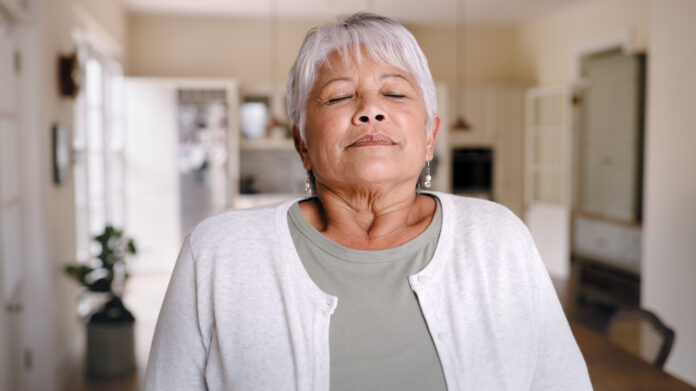If you have high blood pressure that you control, or try to control, with diet, exercise, weight loss, and other lifestyle measures—and perhaps even medication—here’s something to consider adding to your arsenal: breath training, technically known as high-resistance inspiratory muscle strength training, or IMST for short. All it takes, some research suggests, is five minutes a day.
Hypertension affects an estimated 116 million Americans and is at least partly responsible for almost 700,000 deaths annually from heart disease and strokes.
Take a deep breath
The latest study on the topic was published in the Journal of Applied Physiology in October 2022. Aggregating the results of five pilot studies, the researchers found that people who breathed in through a simple handheld device that looks kind of like an asthma pump, for just five minutes daily, lowered their systolic blood pressure (the top number) by nine points, on average, and diastolic pressure (the bottom number) by four points.
It may not sound like much of a drop. But the researchers cite evidence that it is consistent with a 30 percent reduction in the risk for cardiovascular disease.
The five pilot studies pooled for a single overall result were small—each with only 20 to 36 participants, for a total of 128 people. But they included a wide swath of adults: those as young as 18 and as old as 82.
The five studies were also well controlled. For six weeks, about half the people were randomly selected to breathe into a machine that was set to provide high resistance against the muscles people use to breathe. Just as the muscles in your arms and legs grow stronger with strength-training machines that resist the pull of those muscles, the handheld devices can be set to resist the force of the muscles you use to take in air (as opposed to breathing it back out), making them grow stronger in the process. They come with several settings, just like exercise machines at the gym.
The other half of the participants were also instructed to breathe into the devices, but in their case, they were set for low resistance to inspiration. In all five studies, everyone was instructed to take 30 breaths a day in a single session, anywhere from five to seven days a week.
Reductions in blood pressure in the group breathing against high resistance began to be seen after just two weeks, but the effects were greater after six weeks. It was not the stronger breathing muscles that did the trick (although increased strength in breathing muscles achieved with similar machines has been shown to improve athletic performance). Rather, the researchers believe the improvements in blood pressure readings may have been the result, at least in part, of less stiffness and wider openings in the blood vessels because of changes in nerve activity resulting from the deep breathing exercises.
Think of your blood vessels as you would a complicated network of garden hoses. If the hoses are stiff and narrowed, it makes it harder for the water to flow through them, putting additional wear and tear on them because higher pressure is needed for the water to run the course. It’s the same when it comes to blood vessels. If they’re stiff and constricted and it’s difficult for blood to push through, it takes more pressure to propel the blood forward, and therefore the pressure on the walls of the blood vessels increases as the blood courses along—the hallmark of high blood pressure. As the system is continuously strained and the blood vessels keep deteriorating, heart disease, stroke, and other problems are more likely to develop, or worsen.
Mario Corona, M.D., a nephrologist and member of our editorial board, is impressed with the results. He says that a reduction in systolic blood pressure of nine points can help someone with kidney disease stay off dialysis longer. “I’m happy when the medications I prescribe can lower systolic pressure by nine points,” he says.
He also likes that the results persisted even six weeks after the participants stopped using the devices, with about 75 percent of their blood pressure reduction holding steady. “High blood pressure is the hammer that kills the heart and kidneys and brain,” he says. “A sustained decrease in systolic blood pressure can translate directly into clinical cash. It means good outcomes.”
Furthermore, Dr. Corona says, those with mild hypertension, like the people in this study, can sometimes be hard to convince that something’s really wrong. They don’t want to take steps such as making lifestyle modifications or using medication. “It’s very refreshing to see something that is non-pharmacological and doesn’t cost $5,000 and takes five minutes a day. Even the most noncompliant of my patients would try that.”
Still, Dr. Corona points out, the study has some significant limitations.
The caveats
While the research looked at adults of all ages, their demographics and health status were rather narrow. For instance, most were white, but hypertension is more common and tends to be more severe in Black people. It is not known how the intervention would have worked in a largely Black population. Furthermore, the participants were only slightly above ideal weight on average, with an average body mass index (BMI) of 26.5 (18.5 to 24.9 is the healthy weight range), when so many Americans with high blood pressure are quite overweight or obese.
Additionally, initial blood pressure readings were no higher than 160/100—higher than the cutoff point for a normal reading of 120/80, but not through the roof. In fact, systolic blood pressure averaged in the 120s (just a few points above normal), while diastolic pressure averaged in the 70s at the start (normal without any intervention).
In other words, the research focused on people who were only marginally at risk for cardiovascular disease. The results cannot be extrapolated to those at higher risk or who already have cardiovascular disease. What difference a daily breathing regimen would make in heavier people with higher blood pressure or in a nonwhite population remains unknown. One might assume that people with very high blood pressure rather than low to moderately high would benefit, but this has not been evaluated.
Many more people would also be necessary to confirm any findings. “Even just to get accurate blood pressure readings is difficult,” Dr. Corona comments, “which is part of the reason you would need to look at large numbers of people.”
It would also pay to study the effects of IMST in comparison with the effects of meditation, relaxation, and deep breathing, which do not require a special device. Indeed, a number of studies have shown that learning a deep breathing technique—a way to help reduce stress through mindfulness—can lower blood pressure significantly, at least in the short term. In one study published in the Journal of Clinical Hypertension in 2021, people admitted to an emergency department with uncontrolled hypertension who learned a specific kind of deep and slow pursed-lip breathing right in the hospital were able to lower their systolic pressure by an average of almost 10 points more than a similar group that had not been trained. Diastolic pressure among the trained group averaged almost eight points lower. How deep breathing for five minutes a day and breathing into a resistance device for five minutes a day would compare over time would be very telling.
“Over time” is key. It’s not clear whether the positive results in the current study would persist six months out, one year out, and beyond, or whether breathing against resistance would have to continue indefinitely, at least a few times a week. Not that such a thing would be bad, Dr. Corona says. Side effects, other than some potential dizziness at the start, are minimal. The worst thing that could happen is that the treatment would be shown not to work over the long term.
BOTTOM LINE: It’s very unlikely that breathing exercises will ever replace any of the proven treatments for hypertension, which include eating more healthfully, losing excess weight, engaging regularly in aerobic exercise, limiting alcohol, not smoking, and, if necessary, taking medication. It could simply be added into the treatment protocol. In the meantime, while more study is needed to confirm or refute the preliminary findings, trying an IMST device is a can’t-hurt/might-help approach. Of course, you’d want to work with your doctor to help determine if using such a device would lower your blood pressure more than the other steps you are already taking.
The inspiratory muscle strength training (IMST) devices used in the research (including POWERbreathe) retail for about $500. But the lead scientist, Daniel H. Craighead, Ph.D., an assistant research professor at the University of Colorado Boulder’s Integrative Physiology of Aging Laboratory, says that adequate devices can be found for under $100. The main factor to consider is whether they can provide a sufficient level of resistance, he says. “I recommend people look for a device that has an inspiratory resistance setting of at least 100 cm H2O. Many of the cheapest devices will have maximum resistance settings well below this, which won’t work for mimicking our research.” You might have to contact the manufacturer for this information.





